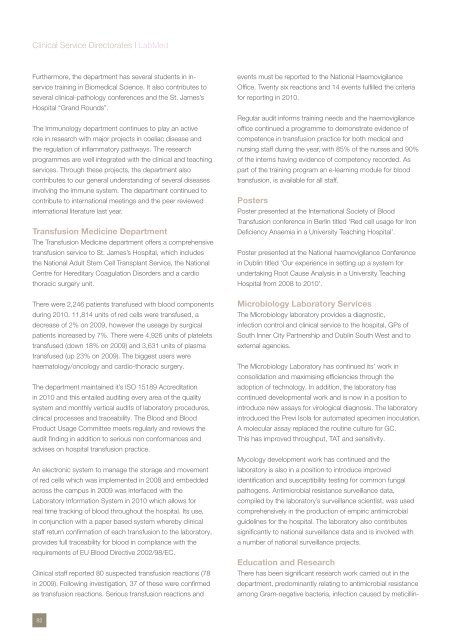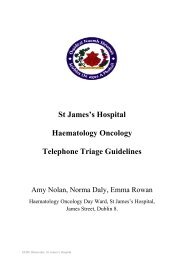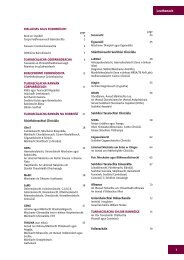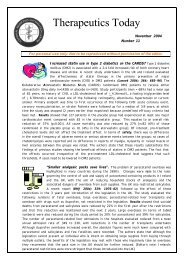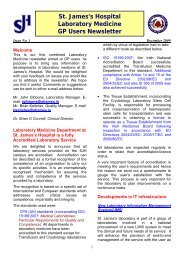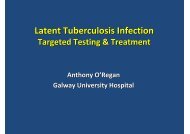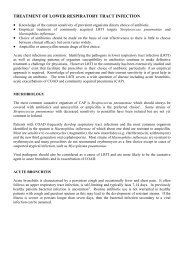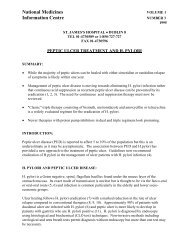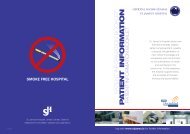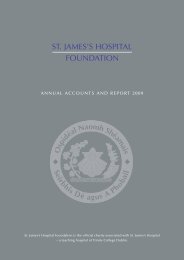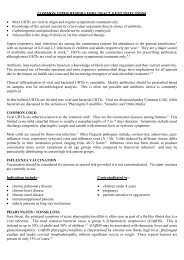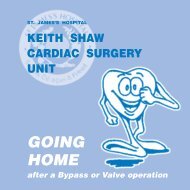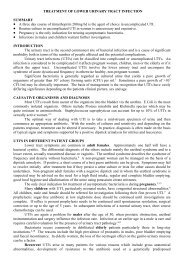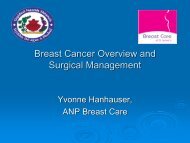Annual Report 2010 - St. James's Hospital
Annual Report 2010 - St. James's Hospital
Annual Report 2010 - St. James's Hospital
Create successful ePaper yourself
Turn your PDF publications into a flip-book with our unique Google optimized e-Paper software.
Clinical Service Directorates I LabMed<br />
Furthermore, the department has several students in inservice<br />
training in Biomedical Science. It also contributes to<br />
several clinical-pathology conferences and the <strong>St</strong>. James’s<br />
<strong>Hospital</strong> “Grand Rounds”.<br />
The Immunology department continues to play an active<br />
role in research with major projects in coeliac disease and<br />
the regulation of infl ammatory pathways. The research<br />
programmes are well integrated with the clinical and teaching<br />
services. Through these projects, the department also<br />
contributes to our general understanding of several diseases<br />
involving the immune system. The department continued to<br />
contribute to international meetings and the peer reviewed<br />
international literature last year.<br />
Transfusion Medicine Department<br />
The Transfusion Medicine department offers a comprehensive<br />
transfusion service to <strong>St</strong>. James’s <strong>Hospital</strong>, which includes<br />
the National Adult <strong>St</strong>em Cell Transplant Service, the National<br />
Centre for Hereditary Coagulation Disorders and a cardio<br />
thoracic surgery unit.<br />
There were 2,246 patients transfused with blood components<br />
during <strong>2010</strong>. 11,814 units of red cells were transfused, a<br />
decrease of 2% on 2009, however the useage by surgical<br />
patients increased by 7%. There were 4,926 units of platelets<br />
transfused (down 18% on 2009) and 3,631 units of plasma<br />
transfused (up 23% on 2009). The biggest users were<br />
haematology/oncology and cardio-thoracic surgery.<br />
The department maintained it’s ISO 15189 Accreditation<br />
in <strong>2010</strong> and this entailed auditing every area of the quality<br />
system and monthly vertical audits of laboratory procedures,<br />
clinical processes and traceability. The Blood and Blood<br />
Product Usage Committee meets regularly and reviews the<br />
audit fi nding in addition to serious non conformances and<br />
advises on hospital transfusion practice.<br />
An electronic system to manage the storage and movement<br />
of red cells which was implemented in 2008 and embedded<br />
across the campus in 2009 was interfaced with the<br />
Laboratory Information System in <strong>2010</strong> which allows for<br />
real time tracking of blood throughout the hospital. Its use,<br />
in conjunction with a paper based system whereby clinical<br />
staff return confi rmation of each transfusion to the laboratory,<br />
provides full traceability for blood in compliance with the<br />
requirements of EU Blood Directive 2002/98/EC.<br />
Clinical staff reported 80 suspected transfusion reactions (78<br />
in 2009). Following investigation, 37 of these were confi rmed<br />
as transfusion reactions. Serious transfusion reactions and<br />
events must be reported to the National Haemovigilance<br />
Offi ce. Twenty six reactions and 14 events fulfi lled the criteria<br />
for reporting in <strong>2010</strong>.<br />
Regular audit informs training needs and the haemovigilance<br />
offi ce continued a programme to demonstrate evidence of<br />
competence in transfusion practice for both medical and<br />
nursing staff during the year, with 85% of the nurses and 90%<br />
of the interns having evidence of competency recorded. As<br />
part of the training program an e-learning module for blood<br />
transfusion, is available for all staff.<br />
Posters<br />
Poster presented at the International Society of Blood<br />
Transfusion conference in Berlin titled ‘Red cell usage for Iron<br />
Defi ciency Anaemia in a University Teaching <strong>Hospital</strong>’.<br />
Poster presented at the National haemovigilance Conference<br />
in Dublin titled ‘Our experience in setting up a system for<br />
undertaking Root Cause Analysis in a University Teaching<br />
<strong>Hospital</strong> from 2008 to <strong>2010</strong>’.<br />
Microbiology Laboratory Services<br />
The Microbiology laboratory provides a diagnostic,<br />
infection control and clinical service to the hospital, GPs of<br />
South Inner City Partnership and Dublin South West and to<br />
external agencies.<br />
The Microbiology Laboratory has continued its’ work in<br />
consolidation and maximising effi ciencies through the<br />
adoption of technology. In addition, the laboratory has<br />
continued developmental work and is now in a position to<br />
introduce new assays for virological diagnosis. The laboratory<br />
introduced the Previ Isola for automated specimen inoculation.<br />
A molecular assay replaced the routine culture for GC.<br />
This has improved throughput, TAT and sensitivity.<br />
Mycology development work has continued and the<br />
laboratory is also in a position to introduce improved<br />
identifi cation and susceptibility testing for common fungal<br />
pathogens. Antimicrobial resistance surveillance data,<br />
compiled by the laboratory’s surveillance scientist, was used<br />
comprehensively in the production of empiric antimicrobial<br />
guidelines for the hospital. The laboratory also contributes<br />
signifi cantly to national surveillance data and is involved with<br />
a number of national surveillance projects.<br />
Education and Research<br />
There has been signifi cant research work carried out in the<br />
department, predominantly relating to antimicrobial resistance<br />
among Gram-negative bacteria, infection caused by meticillin-<br />
82


